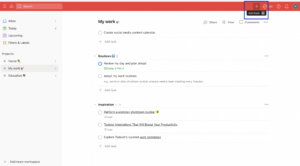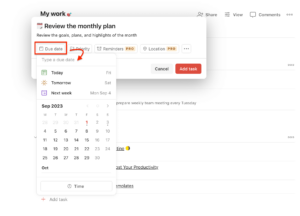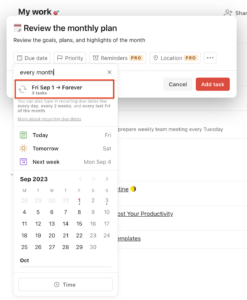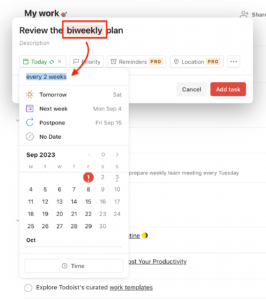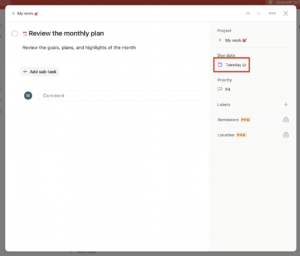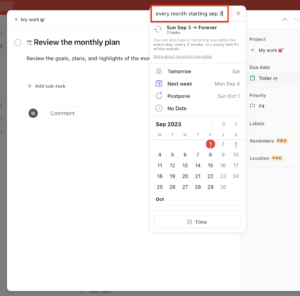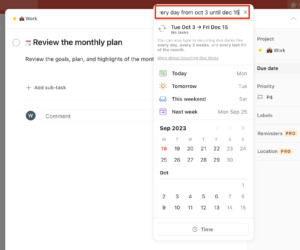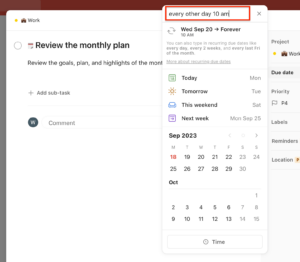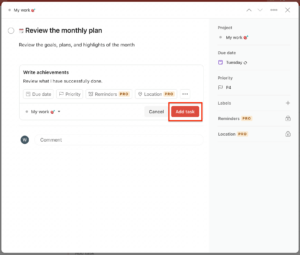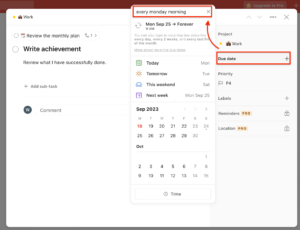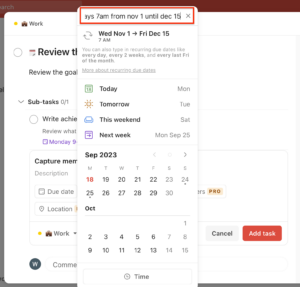Key Takeaways: Recurring Todoist Tasks
- Todoist recurring tasks are very useful for managing and automating repeating tasks, such as weekly team meetings or monthly reports.
- Todoist allows you to set a recurrence pattern, specify a start and end date, and set a due time for main tasks and subtasks.
- You can use natural language to create and configure recurring tasks by simply typing phrases like “every Monday” or “every 10 days at 1 p.m.”
Todoist is a task management app with an easy-to-use listing interface. One of its helpful features, Todoist recurring tasks, allows you to set tasks that repeat at specific intervals — daily, weekly, monthly or even custom-defined intervals. This allows you to save your time and effort, while ensuring that important tasks are never forgotten or overlooked.
In this guide, we’ll walk you through how to create recurring tasks in Todoist step-by-step. That’s not all; we’ll also provide ideas and tricks to enhance your productivity with recurring tasks. If you want to dive deep into Todoist’s full features, check out our Todoist review. Looking for Todoist alternatives? Give our list of the best project management software a read.
Todoist Recurring Tasks Explained
A recurring task is a single task that repeats itself on a regular basis, such as reminders for your morning routine, weekly project check-ins or monthly bill payments.
Instead of creating the same task over and over again, with Todoist recurring tasks, you can set up a task that repeats at a specified frequency and for a certain amount of time. Todoist will automatically move repeating tasks to the next due date once you’ve finished them.
The recurring tasks feature is available on all Todoist plans: Free, Pro, Starter and Business. It’s a great tool to help you stay on top of your regular to-dos, establish good habits and keep your productivity on point (read our productivity apps suggestions for more).
How to Create Recurring Tasks in Todoist
We will show you how to create recurring tasks, specify start and end dates and create recurring subtasks within tasks using Todoist. Follow the steps below to get started.
- Add a New Task
Open the Todoist app or website and go to the project where you want to create a recurring task. Click on the “+” icon at the top-right of the screen or press “Q” on your keyboard to add a new task. In the task input field, type in the description of your task.

- Configure Recurrence
Click on the “due date” button below the task description field. In the “type a due date” field, you can set a recurring due date using natural language. For example, if you want the task to repeat every month, simply type “every month” or “monthly.” Todoist will automatically recognize and interpret your input.

- Save the Recurrence Pattern
After typing, you’ll see the recurring schedule options underneath the text field. Select the option pattern that matches your task’s frequency and click on the “add task” button. Your recurring task will then be set up in Todoist.

- Set a Recurrence in Task Title
You can quickly set and save a recurrence by typing a keyword in the “task name” field when creating a task. It will be given a recurrence automatically.

- Adjust Recurring Setting
To customize the task’s frequency, click on the task and select the date under “due date.” Type the new recurring schedule and save the changes. You can also postpone the task to start in the next cycle by clicking the “postpone” button.

{“@context”:”https:\/\/schema.org”,”@type”:”HowTo”,”name”:”How to Create Recurring Tasks in Todoist”,”description”:”These step-by-step instructions show how to create recurring tasks in Todoist.”,”totalTime”:”P00D02M00S”,”supply”:0,”tool”:0,”url”:”https:\/\/www.cloudwards.net\/todoist-recurring-tasks\/#how-to-create-recurring-tasks-in-todoist”,”image”:{“@type”:”ImageObject”,”inLanguage”:”en-US”,”url”:”https:\/\/www.cloudwards.net\/wp-content\/uploads\/2023\/10\/How-to-Create-Todoist-Recurring-Tasks.png”},”step”:[{“@type”:”HowToStep”,”name”:”Add a New Task “,”position”:1,”url”:”https:\/\/www.cloudwards.net\/todoist-recurring-tasks\/#add-a-new-task”,”itemListElement”:{“@type”:”HowToDirection”,”text”:”Open the Todoist app or website and go to the project where you want to create a recurring task. Click on the “+” icon at the top-right of the screen or press “Q” on your keyboard to add a new task. In the task input field, type in the description of your task.\n”},”image”:{“@type”:”ImageObject”,”inLanguage”:”en-US”,”url”:”https:\/\/www.cloudwards.net\/wp-content\/uploads\/2023\/10\/add-Todoist-task.png”}},{“@type”:”HowToStep”,”name”:”Configure Recurrence “,”position”:2,”url”:”https:\/\/www.cloudwards.net\/todoist-recurring-tasks\/#configure-recurrence”,”itemListElement”:{“@type”:”HowToDirection”,”text”:”Click on the “due date” button below the task description field. In the “type a due date” field, you can set a recurring due date using natural language. For example, if you want the task to repeat every month, simply type “every month” or “monthly.” Todoist will automatically recognize and interpret your input.\n”},”image”:{“@type”:”ImageObject”,”inLanguage”:”en-US”,”url”:”https:\/\/www.cloudwards.net\/wp-content\/uploads\/2023\/10\/add-recurrence-Todoist.png”}},{“@type”:”HowToStep”,”name”:”Save the Recurrence Pattern”,”position”:3,”url”:”https:\/\/www.cloudwards.net\/todoist-recurring-tasks\/#save-the-recurrence-pattern”,”itemListElement”:{“@type”:”HowToDirection”,”text”:”After typing, you\u2019ll see the recurring schedule options underneath the text field. Select the option pattern that matches your task’s frequency and click on the “add task” button. Your recurring task will then be set up in Todoist.\n”},”image”:{“@type”:”ImageObject”,”inLanguage”:”en-US”,”url”:”https:\/\/www.cloudwards.net\/wp-content\/uploads\/2023\/10\/save-recurrence-pattern.png”}},{“@type”:”HowToStep”,”name”:”Set a Recurrence in Task Title “,”position”:4,”url”:”https:\/\/www.cloudwards.net\/todoist-recurring-tasks\/#set-a-recurrence-in-task-title”,”itemListElement”:{“@type”:”HowToDirection”,”text”:”You can quickly set and save a recurrence by typing a keyword in the “task name” field when creating a task. It will be given a recurrence automatically.\n”},”image”:{“@type”:”ImageObject”,”inLanguage”:”en-US”,”url”:”https:\/\/www.cloudwards.net\/wp-content\/uploads\/2023\/10\/set-recurrence-task-title.png”}},{“@type”:”HowToStep”,”name”:”Adjust Recurring Setting “,”position”:5,”url”:”https:\/\/www.cloudwards.net\/todoist-recurring-tasks\/#adjust-recurring-setting”,”itemListElement”:{“@type”:”HowToDirection”,”text”:”To customize the task’s frequency, click on the task and select the date under “due date.” Type the new recurring schedule and save the changes. You can also postpone the task to start in the next cycle by clicking the “postpone” button.\n”},”image”:{“@type”:”ImageObject”,”inLanguage”:”en-US”,”url”:”https:\/\/www.cloudwards.net\/wp-content\/uploads\/2023\/10\/adjust-recurrence-pattern.png”}}]}
How to Specify a Start and End Date for Todoist Recurring Tasks
You can easily specify and modify a start date and end date for recurring tasks in Todoist. Here’s how it works.
- Set a Start Date
Open Todoist and click on the task that you want to set the recurring date for. Use natural language to schedule a start date. For example, you can type “every month starting sep 3” to set a monthly recurring task starting on Sept. 3.

- Set an End Date
Type a prompt that specifies when the recurring task will stop repeating: For example, “every day ending dec 15.” You can also specify both a start and end date by using a phrase like “every day from oct 3 until nov 15.” Alternatively, you can set a specific duration by typing a phrase like “every third friday for three months.”

- Set a Due Time
Want to set a time for your recurring tasks to happen? Just include a prompt, like “every other day at 10 am.” If you want to include both a date and a due time in a prompt, make sure to put a date at the end. For example, Todoist will not recognize the time for “every 10 days starting oct 3 at 1 pm,” so use “every 10 days at 1 pm starting oct 3” instead.

How to Make Todoist Recurring Tasks With Subtasks
Subtasks are the smaller steps that make up the main task. You can create recurring subtasks within tasks in Todoist, as well as set a start and end date, by following the steps below.
- Add Subtasks
Open the recurring parent task you want to add subtasks to. Click on the “add subtask” button below the main task’s description. Type in the details of your subtask and click the “add task” button. Repeat this step to add more subtasks. You can even add subtasks within a subtask by following the same process.

- Configure Recurrence for Each Subtask
Setting a recurring task for a subtask is the same as setting one for a parent task. Click on the “due date” button and enter phrases in the text field, such as “every monday morning” or “every other week,” to set how often the subtask should repeat.

- Set a Start and End Date
Set a start and end date for the subtask by typing in the dates, such as “every 14 days 7am from nov 1 until dec 15.” Todoist will update the task accordingly, and that’s it — your subtask is now all set.

Is the Process for Setting Up Recurring Tasks on Todoist the Same on All Devices?
Yes, the process for setting up Todoist recurring tasks is consistent and user-friendly across all devices, whether you’re using the web version, the desktop app or mobile apps (iOS or Android). There is one thing to note: Todoist currently doesn’t support due dates in Czech and Turkish but is working on it and plans to add support in these languages.
Additionally, Todoist’s synchronization ensures that any changes made to recurring tasks — including their settings, due dates and subtasks — will be automatically updated across all devices.
You can also personalize task actions to display and in what order with the “quick add” feature, and your settings will automatically sync across all platforms. This ensures that you can efficiently manage your tasks no matter where you are or what device you’re using.
Todoist Recurring Task Ideas & Tricks to Enhance Productivity
Todoist recurring tasks can bring a new level of organization and efficiency to your everyday situations. Here are some ideas and tricks to help you integrate recurring tasks into your life with ease.
1. Manage Your Calendar With Todoist
If you have a weekly team meeting or a monthly appointment, these can easily slip through the cracks in your busy schedule. Turning them into recurring tasks on Todoist will help you effectively create routines, manage your schedule and meet deadlines.
You can also filter tasks. Filters let you create custom views for your tasks based on their name, due date, project, label, priority, date created and so on. This way, you can quickly find all the relevant tasks in one place.
2. Create a Weekly Grocery List
Managing grocery shopping and keeping track of kitchen inventory can be a challenging task. Creating recurring tasks for your shopping day, then adding subtasks to break down your list into categories — fruits, vegetables, pantry items, etc. — can make it much easier.
Use Todoist’s collaboration feature to share your grocery list with family members or roommates, so everyone can contribute. You can share it with up to five people on the free plan.
3. Stay Healthy With Todoist Recurring Tasks
Your health matters. You can make it a priority by scheduling recurring tasks in Todoist. Set reminders for daily exercise, meditation or taking any necessary supplements. You can also use recurring subtasks to break down larger health-related goals into manageable steps.
4. Improve Personal Development
Reading a book, practicing a new skill or reflecting on your goals may seem like a small step, but engaging in these activities daily can make a huge difference. To effectively use Todoist for personal development, start by creating a new task for your goal, such as learning a new language. Then, create recurring subtasks within that task to break it into more approachable steps.
You can set Todoist to send you reminders at a designated frequency, which can help to keep you moving in the right direction.
5. Check-In and Manage Your Finances
You can start developing healthy financial habits by creating Todoist recurring tasks to remind yourself to review your budget and track your expenses regularly. Setting due dates can help you keep track of your upcoming financial obligations, such as bill payments, loan installments and subscription renewals.
A tip to stay in control of your financial commitments: Integrate Todoist with other financial apps or tools to streamline your financial management process.
Final Thoughts: Recurring Task in Todoists
Using Todoist recurring tasks is a great way to stay organized and improve productivity, whether for an individual or a small team (read our guide on small team project management tools). You can easily use natural language to create recurring tasks, set a recurrence pattern, and specify a start and end date for main tasks and subtasks.
While it is convenient and flexible, it can be confusing which keywords to enter or in what order. There are numerous ways to implement recurring tasks in your life and business.
What app are you currently using to create and manage recurring tasks? How do you plan on improving your life or business with Todoist recurring tasks? What ideas and tricks from this guide will you likely implement? Feel free to comment below. Thank you very much for reading.
FAQ: Set Recurring Tasks
-
A recurring task in Todoist is a task that automatically repeats at specified intervals, helping you manage repetitive activities without manually creating new tasks each time.
-
Yes. Setting up recurring tasks is easy with Todoist. You can specify a recurrence pattern, start date and end date for the task by using natural language.
-
You can undo a completed recurring task only right after you finish it by clicking “undo” in the pop-up in the bottom-left corner of the screen. However, the pop-up only displays for a few seconds. You won’t be able to undo the completed recurring task once the pop-up disappears.
{“@context”:”https:\/\/schema.org”,”@type”:”FAQPage”,”mainEntity”:[{“@type”:”Question”,”name”:”What Is a Recurring Task in Todoist?”,”acceptedAnswer”:{“@type”:”Answer”,”text”:”
A recurring task in Todoist is a task that automatically repeats at specified intervals, helping you manage repetitive activities without manually creating new tasks each time.\n”}},{“@type”:”Question”,”name”:”Are Todoist Recurring Tasks Easy to Set Up?”,”acceptedAnswer”:{“@type”:”Answer”,”text”:”
Yes. Setting up recurring tasks is easy with Todoist. You can specify a recurrence pattern, start date and end date for the task by using natural language.\n”}},{“@type”:”Question”,”name”:”How Do You Undo a Recurring Completed Task in Todoist?”,”acceptedAnswer”:{“@type”:”Answer”,”text”:”
You can undo a completed recurring task only right after you finish it by clicking “undo” in the pop-up in the bottom-left corner of the screen. However, the pop-up only displays for a few seconds. You won’t be able to undo the completed recurring task once the pop-up disappears.\n”}}]}
The post How to Create Todoist Recurring Tasks in 2023 appeared first on Cloudwards.

